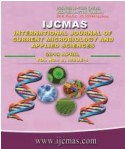


 National Academy of Agricultural Sciences (NAAS)
National Academy of Agricultural Sciences (NAAS)

|
PRINT ISSN : 2319-7692
Online ISSN : 2319-7706 Issues : 12 per year Publisher : Excellent Publishers Email : editorijcmas@gmail.com / submit@ijcmas.com Editor-in-chief: Dr.M.Prakash Index Copernicus ICV 2018: 95.39 NAAS RATING 2020: 5.38 |
A field experiment was conducted at the ICAR Research farm Medziphema, Nagaland (25°50′24″N latitude and 93°50′26″E longitude) during the summer season of 2017 with green gram as test crop. Organic manures viz. Farm Yard Manure (FYM) and vermicompost were combined with biofertilizers viz. Rhizobium and phosphate solubilizing bacteria (PSB) in different combinations and were evaluated in a Randomized Block Design with three replications. The combination of vermicompost @ 5 t ha-1 + co-inoculation with Rhizobium + PSB(T7) proved to be the best treatment in terms of maximum number of nodules (41.33, 44, 18.67 at 30, 45, 60 DAS respectively), the highest grain yield (13.92 q ha-1), total biomass yield (89.77q ha-1) and nutrient ( N, P, K) uptake. No significant variation was recorded in terms of soil physical parameters under study. However, available nitrogen and organic carbon content was significantly influenced in treatment T7 and T4 with vermicompost and FYM along with co-inoculation of Rhizobium and PSB. Population of Rhizobium and PSB (58.33×104 and 56 ×104 CFU g-1 soil respectively), soil microbial biomass carbon (1603.91 μg g-1soil), dehydrogenase and acid phosphatase activity was also significantly higher in T7. However, sole inoculation of nitrogen fixers with either of the manures failed to produce similar effects. Thus combined application of manures and biofertilizers can be recommended as nutrient management strategy for yield enhancement and soil quality maintenance of green gram cultivation in acid soils of north eastern region of India.
 |
 |
 |
 |
 |